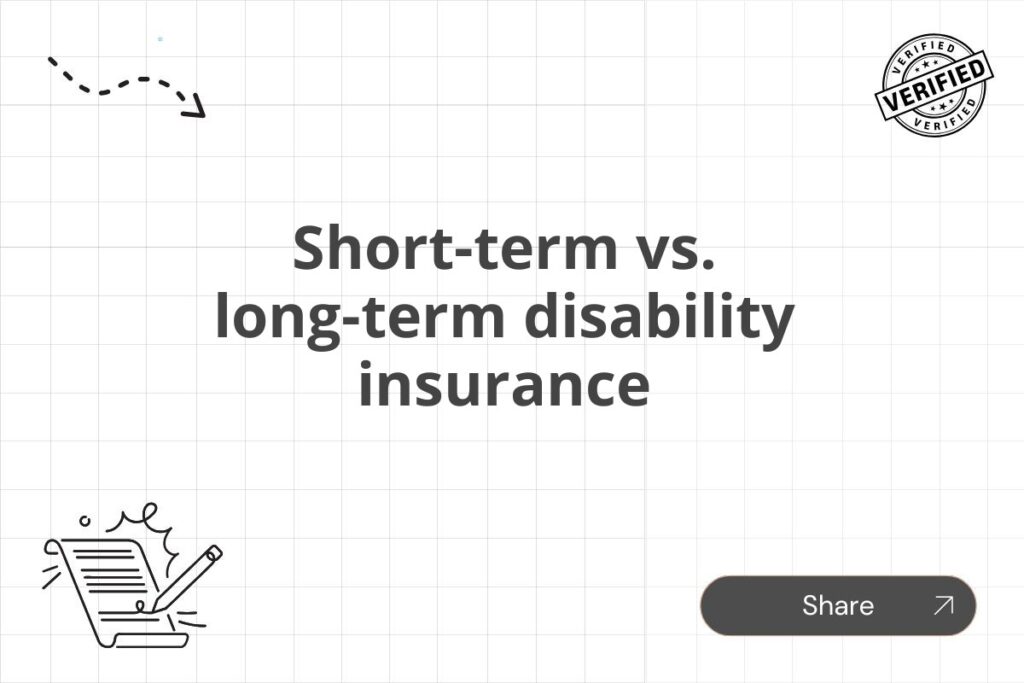Meta Description: Understand the crucial differences between short-term and long-term disability insurance. Learn which policy best protects your income during illness or injury, and how to choose the right coverage for your needs. Compare benefits, durations, and costs now!
Navigating the world of disability insurance can feel overwhelming. The sheer number of policies and the complex terminology often leave individuals unsure about the best coverage for their needs. Two fundamental types of disability insurance stand out: short-term disability (STD) and long-term disability (LTD). While both aim to replace lost income due to illness or injury, they differ significantly in their coverage periods, benefits, and eligibility requirements. Understanding these differences is crucial to making an informed decision that protects your financial well-being.
This comprehensive guide will delve into the nuances of short-term versus long-term disability insurance, empowering you to choose the right policy to safeguard your future.
Short-Term Disability Insurance (STD)
Short-term disability insurance provides income replacement for a limited period, typically ranging from a few weeks to six months. It’s designed to cover temporary disabilities resulting from illness or injury, bridging the gap until you can return to work. The benefit amount is usually a percentage of your pre-disability income, typically between 50% and 70%.
Key Features of STD:
- Shorter Benefit Period: Coverage typically lasts from a few weeks to six months.
- Lower Premiums: Due to the shorter coverage period, premiums are generally lower than LTD.
- Eligibility Requirements: Usually requires a waiting period (elimination period) before benefits begin, typically 1-7 days.
- Benefit Calculation: Benefits are usually a percentage of your pre-disability income.
- Often Included in Employer Plans: Many employers offer STD as part of their employee benefits package.
- Less Stringent Eligibility: Generally easier to qualify for than LTD.
When is STD Beneficial?
STD is ideal for covering temporary setbacks, such as:
- Minor surgeries requiring short-term recovery.
- Short-term illnesses like the flu or bronchitis.
- Injuries resulting from accidents with relatively quick healing times.
- Pregnancy and childbirth (depending on the policy).
Long-Term Disability Insurance (LTD)
Long-term disability insurance is designed to provide income protection for extended periods, often lasting several years or until retirement age. This type of insurance is crucial for individuals facing disabilities that prevent them from returning to work for an extended period. The benefit period and payment amount vary by policy, but typically, LTD policies offer payments for a percentage of pre-disability income, potentially lasting decades.
Key Features of LTD:
- Longer Benefit Period: Coverage can extend for years, sometimes until retirement age.
- Higher Premiums: Due to the longer coverage period, premiums are generally higher than STD.
- Longer Elimination Period: Typically has a longer waiting period (elimination period) before benefits begin, ranging from 30 to 180 days or even longer.
- Benefit Calculation: Benefits are usually a percentage of your pre-disability income.
- More Stringent Eligibility Requirements: Often requires proof of a severe and disabling condition.
- Potential for Benefit Increases: Some policies offer cost-of-living adjustments to benefits over time.
- Often Requires Medical Examination: The insurer might require a medical examination to assess your eligibility.
When is LTD Beneficial?
LTD is crucial for protecting against disabilities that severely impact your ability to work, such as:
- Chronic illnesses like cancer, multiple sclerosis, or heart disease.
- Severe injuries resulting in permanent disability.
- Mental health conditions that significantly impair work capacity.
Comparing STD and LTD
The following table summarizes the key differences between short-term and long-term disability insurance:
| Feature | Short-Term Disability (STD) | Long-Term Disability (LTD) |
|---|---|---|
| Benefit Period | A few weeks to six months | Years, potentially until retirement |
| Premiums | Lower | Higher |
| Elimination Period | Shorter (1-7 days) | Longer (30-180 days or more) |
| Benefit Amount | Percentage of pre-disability income (50-70%) | Percentage of pre-disability income (50-70%) |
| Eligibility Requirements | Less stringent | More stringent |
| Typical Uses | Temporary illnesses or injuries | Long-term illnesses or disabling injuries |
Choosing the Right Disability Insurance
The best type of disability insurance depends on your individual circumstances, financial situation, and risk tolerance. Consider the following factors:
- Your Occupation: High-risk occupations may warrant more comprehensive coverage.
- Your Health: Pre-existing conditions might affect your eligibility and premiums.
- Your Financial Situation: How much income replacement would you need to maintain your lifestyle?
- Your Age: Younger individuals may prioritize short-term coverage, while older individuals might favor long-term protection.
- Employer-Provided Coverage: Check if your employer offers any disability insurance benefits.
Many individuals benefit from a combination of STD and LTD, creating a comprehensive safety net against various disability scenarios. Consulting with a financial advisor or insurance broker can provide personalized guidance on selecting the right coverage that aligns with your specific needs and budget.
Frequently Asked Questions (FAQs)
Q: Can I get both short-term and long-term disability insurance?
A: Yes, many individuals opt for both STD and LTD to provide comprehensive income protection during periods of disability.
Q: What is the elimination period?
A: The elimination period is the waiting period before disability benefits begin. It varies depending on the policy.
Q: How much does disability insurance cost?
A: The cost varies greatly depending on factors like age, health, occupation, benefit amount, and policy duration. Premiums for LTD are typically higher than for STD.
Q: What if my disability is not covered by my policy?
A: It’s crucial to carefully review the policy’s terms and conditions to understand the specific coverage provided. Some policies may have exclusions or limitations.
Q: How do I apply for disability insurance?
A: You can typically apply for disability insurance through an insurance broker, directly from an insurance company, or through your employer’s benefits program.
In conclusion, understanding the differences between short-term and long-term disability insurance is critical for protecting your financial stability. By carefully considering your individual needs and circumstances, you can choose the appropriate coverage to safeguard your future against unexpected disabilities.






















